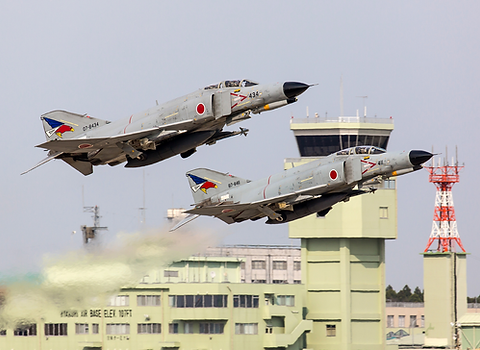








Hyakuri, Iberaki Prefecture, Japan
My first-ever visit to Japan took place between the 13th and 17th of April 2015, during the sacred cherry blossom season. The purpose of the journey was to visit Hyakuri Air Force Base in the Ibaraki Prefecture region.




























In 1937 the airfield was developed by the Imperial Japanese Navy with much of the land claimed from local farmers. At the end of WWII the local farmers reclaimed the land but the Japan Air Self-defence Force (JASDF) reopened the Air Base in 1956.
Nowadays Hyakuri is the primary fighter jet base operating in the Tokyo area. Its main objective is to provide air defence with 7 Kokudan (Air Wing) as part of the Central Air Defence Force. Two squadrons are assigned to the air wing; 302 Hikotai, flying with the F-4EJ Kai Phantom II and 305 Hikotai flying the F-15(D)J Eagle. Both squadrons have a number of T-4's for training and liaison duties.
These Phantoms wear an attractive green/brown camouflage pattern. At the time of writing at least one RF-4E has been converted to trial a new vibrant 'maritime' scheme.
A highlight to behold for any enthusiast visiting Hyakuri is being able to view the sole photo reconnaissance squadron (Teisatsu Kokutai) within the JASDF; 501 Hikotai, flying a mix of original RF-4E Phantom IIs with the photo nose and converted RF-4EJ Kai Phantom II, carrying photo pods under the fuselage.
The Hikotai are supplemented by the Hyakuri Kyunantai, the local Rescue Air Wing squadron. There are at least two U-125A recce aircraft and a same number of UH-60J Black Hawks that are assigned to Search and Rescue tasks. The Rescue Air Wing (Koku Kyunandan) is part of the Air Support Command and squadrons are based at several air bases in the Country. In addition to the types mentioned above the squadron also operates the CH-47J Chinook.
It is not only military activity that can be found at Hyakuri. Following the construction of a new parallel runway and terminal to the west of the airfield in 2010, civil operations began at the base. As a result the base is also known to locals as Ibaraki Airport. In future years it is likely that civil operations will take over the airfield making it the third largest airport in the Tokyo region. However, the good news for the time being is that with only a small number of civil flights per week, the main operator is still the JASDF.
Functioning as a military base, civil airport and surrounded by agricultural fields, one might assume that the base is difficult to access from a photography aspect - this could not be further from the truth. Hyakuri is one of, if not 'the best', bases I have visited for access without having to obtain permission from the military to walk onto the airfield itself. The runway thresholds are accessible from each end and close proximity, particularly to the western-most runway, means that on occasion 100mm can be too much.
In the morning one of the best locations is undoubtedly 'The Shrine', named as such because there is a memorial set within the grounds. This small parcel of land which extends into the hip of the airfield was retained as a spiritual place. Although a memorial and spiritual shrine, the land owners have kindly erected two tall wooden towers on the site that have superior views across to the operational ramp and airfield.The site and viewing towers should not be underestimated of their potential for delivering stunning images.
My thanks goes to Ryo Matsuki, Junji Sato and a wealth of kind people providing information about Japan from various aviation forums.

